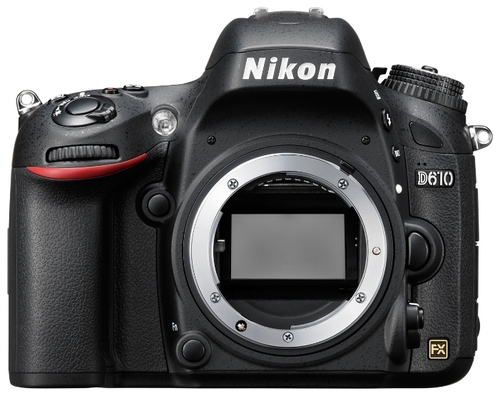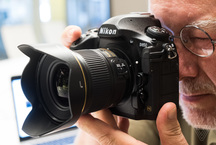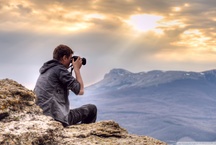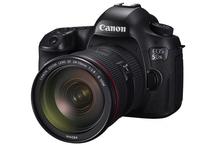
Specifications
| Matrix | |
|---|---|
| Total number of pixels | 24.7 million |
| Effective Pixels | 24.3 million |
| The size | Full frame (35.9 x 24 mm) |
| Crop factor | 1 |
| Maximum resolution | 6016 x 4016 |
| Matrix type | CMOS |
| Color depth | 42 bits |
| Sensitivity | ISO 100 - 6400 |
| Extended ISO | ISO12800, ISO25600 |
| Matrix cleaning function | there is |
| Functionality | |
| White balance | automatic, manual installation, from the list, bracketing |
| Flash | built-in, up to 12 m, the suppression of the red-eye effect, shoe, sync contact, i-TTL |
| Image Stabilizer (still photography) | missing |
| Shooting modes | |
| Shooting speed | 6 frames / sec |
| Timer | there is |
| Timer time | 2, 5, 10, 20 c |
| Time-lapse mode | there is |
| Aspect ratio (still photography) | 3:2 |
| Lens | |
| Interchangeable lens support | Nikon F bayonet |
| Lens included | not |
| Viewfinder and LCD screen | |
| Viewfinder | mirror (TTL) |
| Using the screen as a viewfinder | there is |
| Viewfinder Field of View | 100% |
| LCD screen | 921,000 points, 3.15 inches |
| Second screen | there is |
| Exposition | |
| Exposure | 30 - 1/4000 s |
| Exposure X-Sync | 1/200 c |
| Manual setting of shutter speed and aperture | there is |
| Automatic exposure processing | shutter priority, aperture priority |
| Exposure Correction | +/- 5 EV in 1/3 steps |
| Exposure metering | 3D color matrix, center-weighted, common (Evaluative), dot |
| Exposure bracketing | there is |
| Focusing | |
| Autofocus type | phase |
| The presence of a "screwdriver" | Yes |
| Autofocus backlight | there is |
| Manual focus | there is |
| Electronic Rangefinder | there is |
| Face focusing | there is |
| Memory and Interfaces | |
| Type of memory cards | SD, SDHC, SDXC |
| Image Formats | 3 JPEG, RAW |
| Interfaces | USB 2.0, HDMI, audio, connector for remote control |
| Nutrition | |
| Battery format | your own |
| Number of batteries | 1 |
| Battery capacity | 900 photos |
| Battery pack | MB-D14 |
| Video and audio recording | |
| Video recording | there is |
| Video recording format | Mov |
| Video codecs | MPEG4 |
| Maximum movie resolution | 1920x1080 |
| Maximum video frame rate | 60 frames / s |
| Maximum frame rate when shooting HD video | 50/60 frames / s with a resolution of 1280x720, 25/30 frames / s with a resolution of 1920x1080 |
| Optical Zoom when recording video | there is |
| Sound recording | there is |
| Other functions and features | |
| Body material | metal |
| Additional features | tripod mount, remote control, orientation sensor, waterproof case, HDR shooting |
| Equipment | accessory shoe cover, rubber eyecup, monitor cover, protective cover, lithium-ion rechargeable battery (with protective cover), charger, eyepiece cover, strap, USB cable, software CD |
| Additional Information | 2 memory card slots, stereo microphone input; GPS-receiver, Wi-fi-adapter, adapter for connecting external power supply - optional |
| Dimensions and weight | |
| The size | 141x113x82 mm, without lens |
| Weight | 760 g, without batteries, 850 g, with batteries; without lens |
Reviews of the camera Nikon D610
Virtues
- Compared with the D7000: 1. The speed of autofocus operation (again, compared with the D7000). 2. Detailing. 3. White balance is better. 4. Lenses have shown their potential. 5. Battery - day work is easy. 6. No oil. 7. Convenience management (well, this is Nikon). 8. Comfortable grip. 9 Lightweight.
disadvantages
- 1. Narrow autofocus area (quickly got used) 2. White balance is still not perfect. 3. I did not look through one broken pixel - well, this is my joint, of course, and, of course, this kid basically does not interfere with anything.
Comment
Purchased this unit to get FF. Indeed, for me, the difference from the D7000 is palpable. If earlier I corrected the white balance sooooo long and painstakingly adjusting the color balance in Photoshop, now this work takes me very little time in the standard Nikon converter - 1 hour for a hundred photos. At the same time, of course, the Magenta still crashes, but not in the same way as in the d7000.In the apartment, without a flash, or on the street in direct sunlight, the auto mode is useless - I, despite the possibility of adjusting the auto-balance, still have to process the pictures, but it really takes much less time, as the raves really became more pliable or something ( I am not talking about their classiness). If you move away from the issues of skenton transmission and switch to another: animals, plants, landscapes, etc. - the color rendition is awesome (while the eyes, due to the absence of faces in the photo, stop telling the brain that they see the wrong BB).
The low noise of the matrix really brings a lot of benefit: I take pictures on the ISO 800-1200 in the children’s room on the Nikon 24-85 (the one that 2.8-4) and just on 85 1.4 (Sigma) - we can say that there is simply no noise. I forgot about noise, although before it life was tin. In this case, it was the old man 24-85, I will not be afraid of this expression, he began to work twice as well, with better and faster quality - he forgot about the Nikon's fifty dollars 1.8. It focuses like a gun, even stopped walking back and forth - it gives great pleasure with its light soft effect.
Honestly: I never worked with a very fast autofocus, so perhaps I’m completely satisfied with its speed here - in AF-C mode, birds are caught (experimented, though on a parrot), and children and cars running to the meeting (where 70 km per hour). The zone is too small, you can’t compare it with the new d7100, but it’s not like FF either.
There are no problems with oil, the detailing allows you to sprinkle pictures significantly and without loss of quality.
Good machine. Recommend!
Kurganov Anton, 2013-12-31 Evaluation 5
Virtues
- Good quality pictures and videos.
- Convenient for portrait photography, for the full frame.
- Large memory buffer, compared with D7100, where only 6 frames were placed. The camera itself is faster in terms of image processing.
- I am pleased with the quality at ISO 6400.
- Like the previous models, the control interface is very convenient, a lot of settings. Several programmable buttons, convenient for reportage photography, when you shoot with one hand.
- Already familiar two slots for memory cards.
- You can still describe many advantages, but this is already the norm for Nikon cameras.
disadvantages
- Soils the matrix. Nikon said that the problem was fixed in this model, but after 5000 frames the matrix needs to be cleaned. The spots are quite large. My colleague has the same problem with d610.
- ISO button has changed position. Very uncomfortable after five years of using other models. I have 4 different models of Nikon for specific purposes and everywhere the control buttons are located differently, but the ISO button has always been in one place.
- The focus area is very small. For a quiet shooting of portraits or landscapes is suitable, but will not be enough for reporting.
- It is not possible to enlarge the picture with the OK button.
- The minimum shutter speed is 1/4000. After D7100 this step is very lacking during portrait shooting.
- You can not change the aperture in video mode. It is necessary to turn off LiveView and change.
- Bad virtual horizon in the viewfinder. Works only in a horizontal position.
Comment
Camera sensations are very mixed. In some places, it surpasses the D7100, but somewhere lags far behind even at the program level. That is, a little bit to correct the firmware and fix the problem with the buttons (described in the shortcomings) and there will be an excellent camera. But marketing is a delicate and often meaningless business.
I took a full-frame model specifically for portrait and tilt-shift shooting. I am satisfied with the purchase, I was already ready for shortcomings.
It helps when shooting events as a second camera with a portrait lens, complementing the first with a zoom.
In the end, I will say that this is a regular Nikon camera with old flaws and improved advantages. If the disadvantages are not very embarrassing, then I recommend taking.
Denisov Nikolay, 2014-12-23 Evaluation 4
Virtues
- 1. Full frame.
- 2. Price (bought on stock for 51 tr.)
- 3. Controls (in comparison with competitors everything is much better).
- 4. Two slots for cards (I am senile, I always have raw bucks on the second card).
- 5. Working ISO 3200 (even 6400, if you take post production into account).
- 6. White balance perfectly exposes (like all new cameras).
- 7. The metering works with a bang.
- 8. Programmable modes / buttons (learn to be sure).
- 9.Build quality level.
- 10. LiveView
- 11. The video is not worse than with the D800.
disadvantages
- 1. Autofocus. Yes Yes. It should be understood that the camera for such money should not wait for indicators like the D700 / d3s / d4s. But you can shoot, you can shoot reports. If you have not shot on the D700 / d3s / d4s, then you will have enough of such a focus and you will be happy with it. Where D700 / d3s / d4s (backlight, mixed light, flickering, etc.) are captured, the D610 will smear, so we put the tracking focus and press a lot of frames, maybe it will. I'm talking about the report (I'm talking about the genre).
- 2. The minimum shutter speed is 1/4000, but you can live with it.
- 3. SD Class 10 is better to use up to 16GB, since 32 GB is already undermining with my mode (raw + backup).
Comment
He took as a safety camera for filming reports (weddings, events, news, and so on). The camera justifies its money completely. Better than analogue from canon (I love canon too, there is no hate here).
I tried to work in conjunction with the D700 / D610 - different presets are needed (for the D610 in the LR black we take twice as much as the D700, and the camera has the blue saturation of the minus 10-15).
Cons at times less than the pros. I do not regret buying. C matrix, a hitch, no problem. The camera is excellent if you are not afraid of flaws, which you can avoid only if you buy D810 or D4s.
Ps. Use high-aperture fixes (I have Sigma f / 1.4, Niokn 50 f / 1.4, Nikon 85 f / 1.8) then you will be satisfied with your camera.
Markov Alexander, 2014-07-31 Evaluation 5
Virtues
- After Nikon D7000 - of course a completely different level.
disadvantages
- Oil on the matrix after 1,356 frames. on the diaphragm from 10 and up. WHAT VERY upset.
Comment
Experience using 2 months. Home mode. Indoors only (winter outside). Yesterday, with pain and distress, I saw 4 points in the upper left corner on each photo. I read about the 600-ku, there was such a problem and said that in 610 it was decided. As it turned out - no. I want to write something good, it is of course. sediment remained unpleasant
lattice Ilya, 2015-02-20 Evaluation 4
Virtues
- - Full frame - now you can fully enjoy the beauty of all glasses created in recent decades!
- - The widest DD + ADR (the widest for the figure, the film is still far away).
- - Relatively light and compact. Good ergonomics. Dust-moisture protection.
- - Excellent AF, fast and accurate, misses much less than on the D80, there is a meager FF / BF depending on the type of light source (who says that the AF is bad, apparently does not know how to use it or the technique is faulty).
- - A good viewfinder, slightly worse than on the D800 (although the same x-ki is declared, the Nikta says different pentaprisms), a little larger than on the sprinkled cameras, but noticeably smaller and darker than on old film mirrors.
- - Ability to use any lenses in A mode (on D80 only in M mode).
- - Accurate focus confirmation indicator (green dot in the viewfinder), on the D80 there was a decent spread across the depth of field.
- - Replaceable focusing screen (although Nikon claimed the opposite), lovers of high-aperture manual glasses will appreciate.
- - Possibility of manual focusing in LiveView mode with multiple magnification of any part of the frame (this is quite enough for macro photography from a tripod, even the focusing screen is not needed).
- - A good drive motorless lenses (screwdriver), faster than in the D80.
- - Quiet and soft shutter (not as clattering as on the D800) with a resource of 150000.
- - 2000-zone matrix metering (against 420 on D80 / D90).
- - Burst shooting up to 6 frames / second + capacious buffer.
- - Fine-tuning the AF of a specific lens (remembers 12 glasses) for the correction of FF / BF.
- - It is possible to use DX lenses (albeit 10 Mp).
- - Almost everything is set up (from a convenient one: hang the exposure compensation and scroll the captured frames on the rear wheel, the ISO value instead of the frame counter on the upper display).
- - Customizable presets U1 and U2, in which you can remember all the camera settings.
- - 2 IR sensors - front and rear.
- - Good build quality and materials - almost indistinguishable from the D800 and D4.
disadvantages
- Small coverage area with AF sensors - only the center of the frame (not critical, the center sensor is most often used, you can use extreme ones with AF blocking and frame rearrangement, I left only 11 out of 39 points).
- 24 MP is not enough for FX, the resolution of high-quality sharp glasses significantly exceeds the resolution of the matrix (but not so huge files like the D800 and fast processing).
- Noticeable color noise in bright areas is already at ISO 1000, even when the noise level is on at short exposures, but ISO 6400 is still quite working.
- The minimum shutter speed is 1/4000 - there will be problems in the bright sun with high-aperture optics (it can be treated with a neutral filter).
- The multi selector (joystick) is a bit small and its shape is inconvenient; sharp edges cut a finger.
- For me, not very comfortable grip, in the D80 was better.
- The magnitude of the exposure compensation is not displayed on the upper display, only in the viewfinder, I would like to see there the same scale as in the viewfinder.
- I would like the same electronic horizon in the viewfinder as on the D800. Its implementation in the D610 via the Fn key is clumsy and inconvenient.
Comment
Although the camera is declared by Nikon as an amateur, but part of the functionality is borrowed from the pro class (for example, the ability to use any lenses in mode A). Directly about the amateur class testifies only the presence of the plot program (mode SCENE).
And finally, the shutter release button is still black :))
Anonim 2014-02-06 Evaluation 4
Virtues
- Full frame, picture quality, convenient control, exposure metering, white balance, build quality
disadvantages
- The price, focus points are collected in the center (a matter of habit, it just seems like there are not enough after the D7100, but everything is used very quickly), shutter speed is 1/4000, and 1/8000 was possible.
Comment
Excellent full-format camera, wide dynamic range, excellent working ISO 3200, 6400 (more or less). Focusing is excellent, fast, accurate. There are a lot of settings for yourself; everyone is comfortable in the efficiency of management. The metering works fine, the white balance is set to 99% correctly without the need for adjustment. The picture quality is much higher compared to the incomplete frame. In general, Nikon has a good camera with an FX matrix.
Sample photos:
http://fotki.yandex.ru/users/almen2006/view/623926
http://fotki.yandex.ru/users/almen2006/view/623927
http://fotki.yandex.ru/users/almen2006/view/623928
http://fotki.yandex.ru/users/almen2006/view/623925
Bartenev Alexey, 2014-09-04 Evaluation 5
Video review of the camera Nikon D610
(test)




